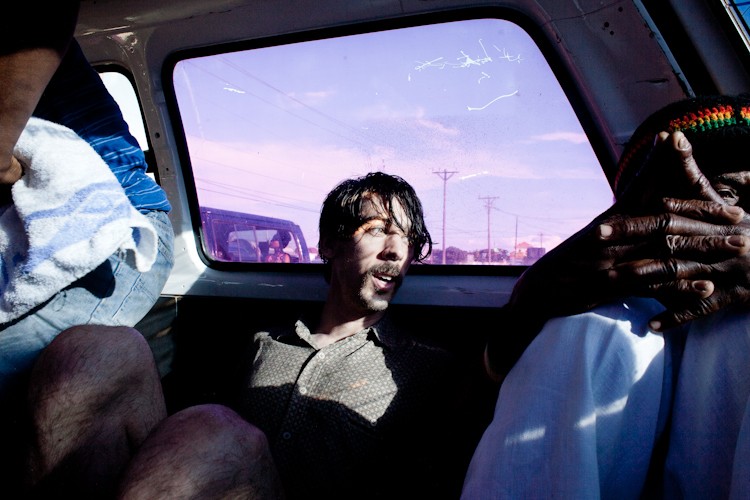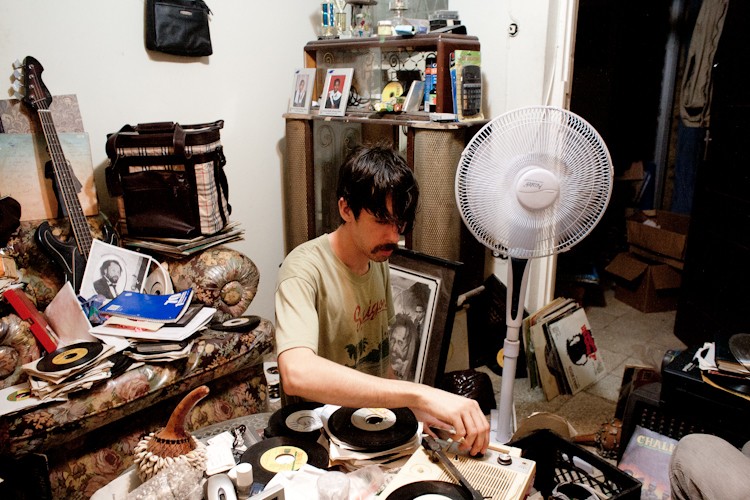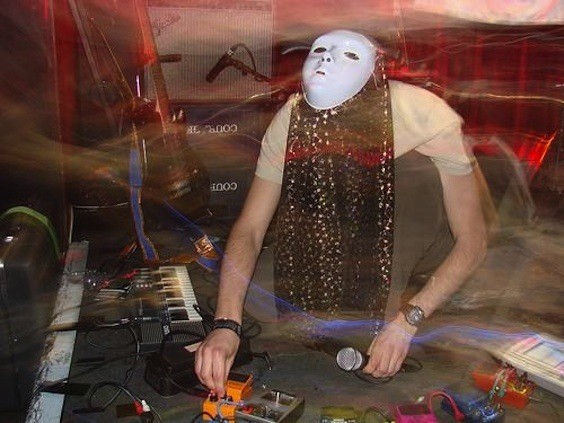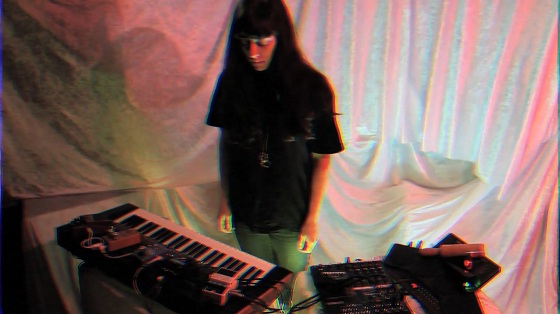Sun Araw “Trawling with big nets” (interview) – the improvisational undercurrent of the audiovisual, the non-linear and the infinite dub

Af Simon Christensen – foto: Alex Welsh / The Fader
Hvis man kan sige, at vi befinder os i en internettets brydningstid (gør vi ikke altid det?), hvor der udspiller sig en definitionskamp over ejerskab, så repræsenterer Sun Araw den fløj, hvor information bevæger sig allermest frit. Credoet er, at information både er det primære input og output inden for kunsten, så derfor bør den være tilgængelig med færrest mulige restriktioner.
Den stærkt inspirerende Los Angeles-multiinstrumentalist, filmmager, improvisator mv. Cameron Stallones har som Sun Araw, gennem selskabet Sun Ark, under aliasset Aristocrat P. Child og via FRKWAYS-samarbejdet med The Congos bevæget sig i en strøm af dub music, eccojams, new age-musik, disco-mixtapes samt audiovisuelle medieværker under titlen Second System Vision Radio. Cameron Stallones har blandt andet også komponeret og fremført værket The (3) Vases på Festival of Endless Gratitude 2013 – og er i det hele taget ekstremt produktiv.
Ud over at være musiker bevæger Sun Araw altid i strømmen af mediets egne indstillinger: På et mikroniveau er hans musik centreret om gentagelsen (understreget af f.eks. dub og ekko). I et bredere perspektiv fletter han musikkulturer og samples i et ufuldendt udtryk af egenproduktion og andres materiale. Og på et makroniveau udkommer Sun Araw både på kassetter, vinyl og især digitalt på tværs af musik, grafik og video. Altid med den største psykedeliske forbindelse til mediet.
I samarbejde med Stallones har vi udgivet en række af hans bedste MIXXES i Passive/Aggressive SOUNDS, hvor de vil være tilgængelige i de kommende måneder (brug shift-click på streamingsiden for hemmelig download).
P/A: Given your very active production of both music, art work, video and more, can you explain where the music of Sun Araw does derive from?
Cameron Stallones: “Music was always first, and later music was even a way to try to realize visual ideas I had that were beyond my technical abilities. The important moments were all the moments when some sort of environment springs into existence around you, it’s endlessly exciting to me. At one moment you are playing some notes, and then all of the sudden you are inside of a space with certain properties, and those properties change the way you perceive everything for as long as the space can exist. I think that happened enough times to me in my bedroom as a teenager that I got more interested in that thing than most other things.”
P/A: What is your approach and view upon improvisation?
CS: “For me it’s still the foundation of the process, simply for the reason that the part of the self that gets used in true improvisation is the intuitive faculty which has better taste than my intellectual processes.”
P/A: Can you give us a brief introduction to how you work and how your life is on a regular basis: Do you make your living playing music, and how often do you play shows?
CS: “Today I live in Los Angeles and work on music all the time. We try to play as often as people will listen.”
P/A: Who is the persona Aristocrat P. Child, who was behind a lot of these early mixxes?
CS: “All we need to say about that guy is that he’s gone. He was very useful and good at what he did for a very long time, but his services were no longer necessary. He’s been replaced by DJ Sí Sí Sí Gracias, who frankly is a lot more fun to chill with.”
P/A: Being Sun Araw-followers for some time, we of course like your psych/echo/dub/jams from your own records on Not Not Fun and Sun Ark. How do you balance the solo work with your outputs of mixtapes and being a record label in Sun Ark?
CS: “Sun Ark was formed as a platform for Sun Araw records, but of course immediately other things started to seem possible. The problem is when something seems possible, it frequently is possible and then you have to start imagining a world with or without that possibility, and for me that usually leads to doing the thing. So I’ve been doing lots of other things. But it’s good because the mixes and working on other people’s records provides me with the time I need to reflect on my next move.”
P/A: Can you tell us a little bit about MIXXES and the SECOND SYSTEM VISION RADIO – what it means to you and why you make/publish them?
CS: “The mixes started as people began to ask for them. The earlier stuff was, in classic style, usually based around a genre: Alex (D/P/I) and I made some disco mixes, things like that. But the mix “ALL YOUR HEART: THE LABEL UNDER THE LABEL” was the beginning of a whole different sort of thing, a thing that had nothing to do with genre. All the mixes since then are part of the same extended conversation where the music is asked and then answers certain questions. What I discovered was that it (the music) had a lot of interesting opinions.”
P/A: In relation to your mixtapes and mixtape-videos, what are you trying to explore with that format, and what is the freedom, fun and achievement in making these mixtapes?
CS: “The Second System Vision Radio videos were an extension of the mixes. The SSVR project revolves around the idea of “nascent digital vision,” meaning the idea that when you begin to see new things, you don’t see them very clearly. But in that ambiguity there is the possibility to re-create what it is you see, because there is a moment before the rational mind can reduce the new thing to an old thing. So the videos became a way to add another element (all of this highly personal video material) to these conversations. It allows the conversation to get more complex because there are all sorts of tensions present between the text, the music, and the image. All of our efforts are subject to certain limitations, which are based on certain structural principles like physics or your attention span or whatever. Those limitations, if you combine them right, start to paint a detailed picture of “how things are,” which can then start a conversation with your picture of “how you want things to be.” So what I mean is: You can ask questions, and then you can get answers – and that whole process changes all the things around you.”
P/A: What kind of ideological statement do you – if any – promote in your way of being both label-man, compiler, designer and musician?
CS: “In my case, it’s based on my history and out of necessity. I just started playing music outside the system and I never got inside it. I do think an important truth of the moment in which we live is that you can do all this stuff yourself, no problem. If someone can help you, that’s good, but a lot of people in the music-world who “want to help you” are not really trying to help you. And this isn’t because they are evil, they are just connected to very old and anemic ideas about art. If you aren’t careful their ideas might get your art sick because ideas are like trails that you walk on, and it’s hard to escape their influence. But there are really good people who do want to help as well, your skill has to be to learn to look and see the nature of their ideas, regardless of what they might say to you. But actually the most important thing is just this thing: Don’t Wait Around For Someone. Someone is a fiction, Do It and It will be Done.”
P/A: What is your relation to Denmark, and do you have any upcoming plans of touring around here any time soon?
CS: “I’ve played in Copenhagen twice, and I would like to come again.”
P/A: Your mixtapes seem to be a blend of your own stuff/editing and a big compilation of music. How do you find material for your mixtapes, and how are they made?
CS: “Trawling with big nets. I usually assemble a big group of stuff that I’ve been listening to lately and then I sit there and spin the mix live and sweat and lose my mind trying to decide what to play after the track that’s playing.”
P/A: What is your view on the remix-culture? In a broader sense, the internet could be viewed as a huge archive of information, only waiting to be discovered, but at the same is completely impossible to navigate due to the massive amount of information available. So how do you navigate, or how should one navigate in order to not get lost?
CS: “I like this picture. I think the good thing about such a vast amount of information is that while it might be difficult to navigate in a linear way, it’s very easy to navigate in a non-linear or intuitive way. Our mind functions on pattern recognition: We can’t help but create patterns from chaotic systems. And so rather than looking for information, information comes looking for you.”
P/A: What styles of music do you especially like, and would you use any genre in your mixtapes? (To me they seem to be focused on any kind of music with ‘soul’/presence).
CS: “There is no consistent genre to any of the mixes after “ALL YOUR HEART”, but I really like the words soul and presence, because when I am working on these mixes I am looking for something that is alive. One of my favorite filmmakers talks about editing scenes like fitting together pipes with different diameters. If you hook it up right, all the sudden there is a current. That’s the part where I’m sweating and losing-my-mind (not a bad strategy) because if the songs get wired properly then all the sudden there is a presence. And you definitely know when it is happening, and you definitely know when it is not happening.”
P/A: How important is the mind’s transcendental and psychedelic qualities of music to you, and how much is dance, funk and physical elements of music?
CS: “”Getting Somewhere” is what I’m after. Also I’ve learned that it’s easiest on yourself not to be a dualist, so I won’t separate transcendental from physical elements.”
P/A: Could you tell us a bit about your thoughts on the choice of aesthestics in your artwork, video-mixtapes and website? It seems very consistent and a little OCD.
CS: “It’s all one process, and it’s all part of the conversation. The hope is to make something that will expand the viewer’s perception of the work and not limit it.”
Info: Sun Araw udsender LP’er løbende og er aktuel med “Belomancie” (2014) og “Gazebo Effect” (2015). Kig også forbi sunaraw.com, hvor Cameron Stallone løbende udgiver materiale.





